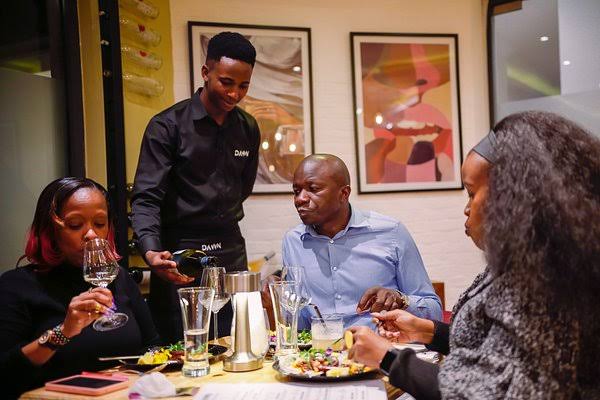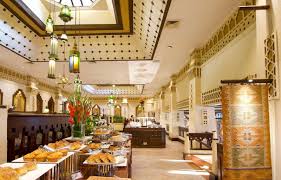Dining is a universal experience, but the way we enjoy our meals can vary drastically depending on where we choose to eat. On one end of the spectrum, you have the bustling, no-frills experience of eating at a kibandaski—a small, roadside eatery serving authentic and affordable Kenyan street food. On the other end, there’s the luxurious, meticulously planned experience of a 15-course meal at a high-end hotel, where every dish is an art form.
In this blog, we’ll explore the differences between these two dining experiences—kibandaski dining and a 15-course meal—and how both offer unique and satisfying ways to enjoy food, each with its own culture, vibe, and value.

1. Atmosphere: Casual Vibes vs. Formal Elegance
The first thing you’ll notice when dining at a kibandaski is the casual, laid-back atmosphere. These roadside joints often consist of a simple structure—think makeshift tents, wooden benches, or plastic chairs. You’ll hear the lively hum of conversations, the sizzle of food being cooked in open-air kitchens, and the occasional honk of passing cars. It’s a place where people come for a quick, hearty meal without fuss or formalities.
In contrast, dining at a 15-course meal in a high-end hotel is a much more structured, elegant affair. The ambiance is quiet, refined, and luxurious, with dim lighting, soft music, and an air of exclusivity. Every detail, from the choice of cutlery to the placement of flowers on the table, is meticulously curated to enhance the dining experience. Guests are seated by a host, and the atmosphere exudes a sense of prestige and celebration.
The Verdict:
- Kibandaski: Casual, energetic, and community-focused.
- 15-Course Meal: Sophisticated, calm, and intimate.
2. Service: Self-Serve vs. Personalized Attention
In a kibandaski, the service is minimal but efficient. There’s typically no waitstaff, and in many cases, you’ll walk up to the counter to order your meal. The chefs, often in full view, whip up fresh plates right before your eyes, giving you a direct connection to the food-making process. The service is fast, direct, and no-nonsense, perfect for those who want a quick bite.
At a high-end restaurant offering a 15-course meal, service is an integral part of the experience. Waitstaff are attentive, often explaining each dish as it arrives and suggesting wine pairings or cocktails to enhance your meal. You might even have a dedicated server for your table, and each dish is carefully presented with detailed descriptions of the ingredients and the chef’s inspiration.
The Verdict:
- Kibandaski: Quick, no-frills, and self-directed service.
- 15-Course Meal: Personalized, attentive, and polished service, designed to enhance the dining experience.
3. Food Variety: Simple Meals vs. Culinary Masterpieces

The food in a kibandaski is often simple but satisfying, consisting of Kenyan staples like ugali, chapati, nyama choma, sukuma wiki, and beans stew. The beauty of kibandaski cuisine lies in its authenticity and affordability. Dishes are cooked with locally sourced ingredients and served in generous portions, giving you a filling meal for a fraction of the price you’d pay elsewhere. The flavors are bold, straightforward, and familiar, often seasoned with spices like cumin, coriander, and ginger.
In contrast, a 15-course meal at a fine dining hotel is a gastronomic journey. Each course is a small, artfully crafted dish designed to excite your palate and challenge your expectations of flavor and presentation. The courses may include exotic ingredients, molecular gastronomy, and unique flavor combinations you’d never expect. Each plate is a masterpiece, often accompanied by a story or explanation of its inspiration. This type of meal is meant to be savored, with each bite offering something new and surprising.
The Verdict:
- Kibandaski: Simple, hearty, and filling, with traditional Kenyan staples.
- 15-Course Meal: Complex, experimental, and innovative, offering a blend of global culinary techniques.
4. Price: Budget-Friendly vs. Luxury Spending
One of the most notable differences between kibandaski and 15-course meals is the cost. A meal at a kibandaski is incredibly affordable, making it accessible to people from all walks of life. You can enjoy a hearty plate of chapati and stew or a generous portion of nyama choma without breaking the bank. It’s the go-to option for anyone looking for good food on a budget.
A 15-course meal, on the other hand, is an investment. The price reflects not only the quality of the ingredients and the skill of the chefs but also the overall dining experience—ambiance, service, and presentation. Such meals are often reserved for special occasions, celebrations, or those looking to indulge in a luxurious culinary adventure.
The Verdict:
- Kibandaski: Extremely affordable, perfect for everyday dining.
- 15-Course Meal: Expensive and indulgent, ideal for special occasions.
5. Time Commitment: Quick Bites vs. Long Evenings

At a kibandaski, the experience is fast-paced. People come in for a quick, hearty meal and then get on with their day. You’re likely in and out within 30 minutes, making it a convenient option for busy days or when you’re on the go.
A 15-course meal, by contrast, is an extended affair. It’s an event that could easily last several hours as each course is served with careful timing and precision. The entire experience is designed to allow you to savor each dish, with plenty of time to enjoy conversation and soak in the luxurious atmosphere.
The Verdict:
- Kibandaski: Quick, functional, and efficient.
- 15-Course Meal: Slow-paced, luxurious, and immersive.
6. Cultural Experience: Local Charm vs. International Influence
Dining at a kibandaski is as much about cultural experience as it is about the food. These local eateries are deeply rooted in Kenyan culture and offer a glimpse into the daily lives of locals. Eating at a kibandaski gives you the chance to experience Kenya’s rich street food culture, where people from all walks of life come together to share a meal.
On the other hand, a 15-course meal at a luxury hotel often blends international culinary influences with local flavors, offering a fusion of global techniques and ingredients. Chefs at these establishments often draw inspiration from a variety of cuisines, providing a cosmopolitan dining experience that reflects the best of global gastronomy.
The Verdict:
- Kibandaski: Rooted in local culture and tradition, offering an authentic Kenyan experience.
- 15-Course Meal: A fusion of global influences, combining local ingredients with international techniques.
Conclusion: Two Sides of the Same Culinary Coin
Dining at a kibandaski and enjoying a 15-course meal in a luxury hotel represent two extremes in the world of food—each offering its own unique and satisfying experience. While the kibandaski provides a quick, affordable, and culturally rich experience for those seeking comfort food, the 15-course meal is a culinary adventure for those who want to indulge in luxury and innovation.
Ultimately, both experiences reflect the diversity and richness of the culinary world, reminding us that food is not just about sustenance, but also about connection, culture, and the joy of discovery—whether in a humble roadside stall or an elegant dining room.




